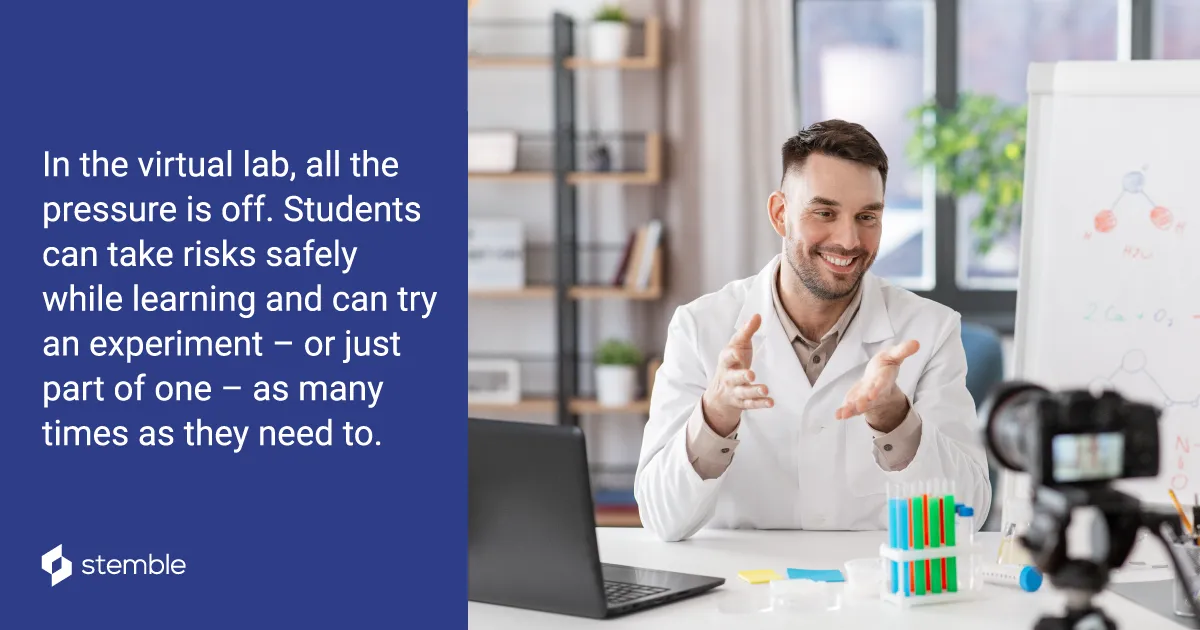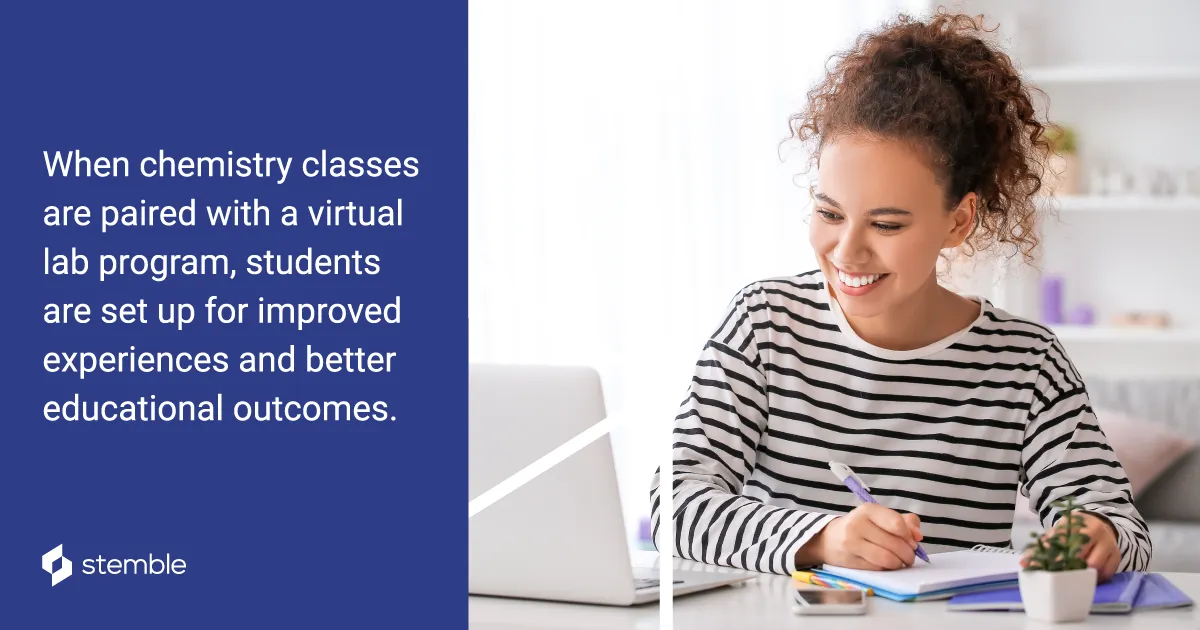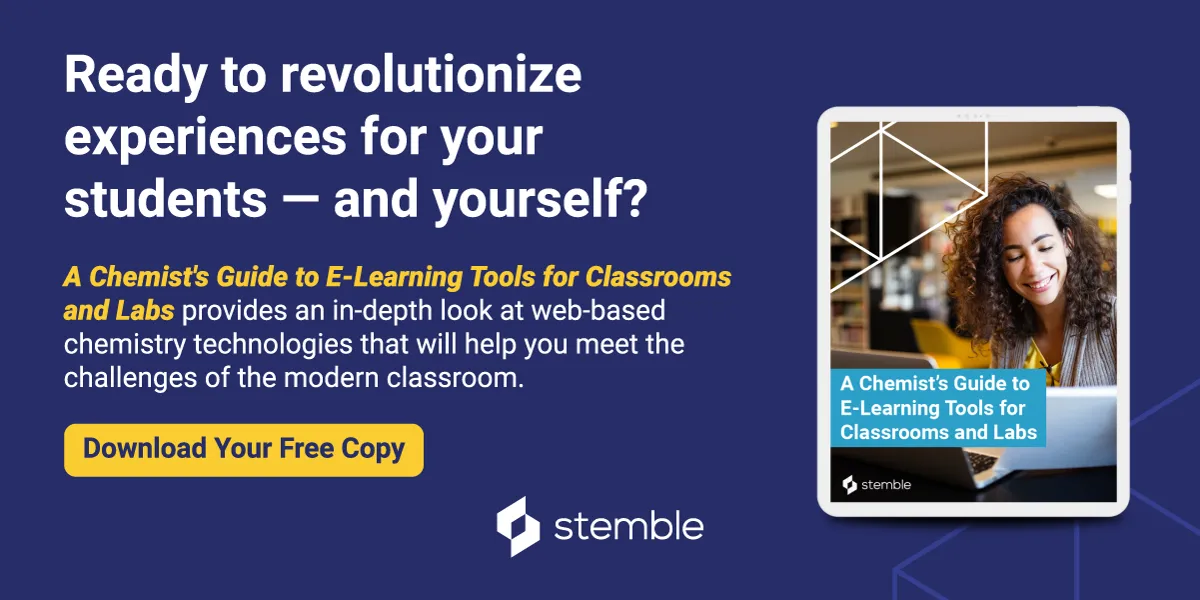8 Ways Online Lab Simulations Can Help Enhance Your College Chemistry Courses
Ever wonder what online lab simulations could do for your college chemistry program?
Prof. Jason Pearson, PhD

Traditionally, chemistry has been taught exclusively using in-person chemistry labs and classes. However, when chemistry classes are paired with a virtual lab program, students are set up for improved experiences and better educational outcomes.
Chemistry is a very tactile science, so it is understandable that some instructors may have doubts about the utility of virtual tools for chemistry. Chemistry is a highly interactive discipline. In a chemistry lab you’re going to be touching glass, observing things with your eyes, measuring and managing equipment. But, while chemistry may be substantial, it doesn’t require a Star Trek holodeck to prepare students to be more competent and confident in the lab.
Due to improvements in software and device capabilities, digital solutions now exist that can be easily incorporated into a traditional college chemistry experience. Ideally, a virtual chemistry app supports students by providing an accessible and realistic tool for lab, homework, quizzes, and other standard assignments. It also supports instructors by providing a scalable program that automates common tasks, enables collaboration, and can customize lab scenarios to suit the course.
While there are many great reasons to consider adding an online lab simulation, we’re sharing eight of the most important.
1. Incentivise Completing Class Assignments
Students are motivated by grades, feedback, and self-confidence. And when motivated, students are willing to do their homework and pre-lab preparations, meaning that they come to in-person labs ready to go.
Virtual chemistry tools encourage students to do assignments and prep work to get good grades (or prevent bad ones). Automated, immediate feedback lets students correct in the moment without having to wait for papers to be graded, so they continue to learn while they’re working. Of course, students who complete homework, lab prep, and assigned practice in the virtual lab will be more likely to approach the in-person lab with confidence. (And they may even be more engaged in lectures!)
Without incentives connected to these motivators, educators don’t get a very high rate of compliance with requests and instructions.
2. Provide Flexibility for Remote Learning
Another benefit of this integration is that some chemistry apps are capable — when necessary — of being a standalone replacement for in-person coursework. For example, our Stemble interactive virtual lab app provided students with access to a robust chemistry education when Canadian universities were closed during the pandemic and relied on remote learning.
The flexibility to offer uninterrupted education when facilities are closed due to weather or community illness — or when a student has missed a lab that’s already been changed over — is an invaluable asset. And while it’s not the same as being in the lab, students remain familiar with the environment — albeit virtually — and are more likely to be ready to hit the ground running when returning to in-person learning.

3. Prioritize Accessibility of All Kinds
Modern chemistry apps are also highly accessible, from both traditional and digital accessibility standards. Students own devices and want to use them in their education, so why not enable that? Students want flexibility and the ability to access materials when it’s convenient for them to learn — and that’s absolutely possible with a digital chemistry experience.
At Stemble, we’ve also focused on making our app financially accessible to students, usable on devices students already own and without requiring software downloads or lots of bandwidth.
4. Leverage Analytics to Improve Student Learning
When using a virtual chem lab app, instructors can incorporate all of the same things they’re accustomed to, only they’re more trackable. You can ask students questions. You can request that they read the lab manual and answer some math problems. You can have them go through and virtually try the simulated experiment. And you’ll know who has engaged with them, in real time, with app-generated analytics.
Analytics that track student behaviors can provide instructors with indications that an individual student may be at risk. If they’re not engaging with the material, for example, you have the opportunity to reach out and ask if they’re having problems. For some students, just knowing that someone is watching out for them can transform their educational experience.
Student data can also help you see if a cohort of students is understanding the material or if they may need additional help with a concept. You can then optimize your instruction to give students exactly what they need to know. Imagine being able to tailor your instruction to a cohort’s specific needs. What would it be like for you to be able to provide students with information that exactly maps to the challenges they’re facing? And more importantly, what would it be like for them?
Students would feel like they were really seen, understood, and truly helped by their instructors, which is a great motivator. Helping students course-correct can prevent frustration and failure, and give students reasons to care about chemistry even if they’re not destined to be chemists.
5. Maintain Academic Integrity
Regrettably, many students confess to cheating in college classes (more than 60%), and it’s easier to do so than ever before. Fortunately, one of the benefits of a modern, digital chemistry simulation is the ability to offer unique data to every student. Using algorithmic simulations means that students can’t search online and get a list of answers. (And even if they do, they’d still have to do the work for their specific numbers, which is, at that point, simply learning material.)
Cheating is much less likely when nobody else is working with the same data. And, it’s very easy to tell if any students are using data that was not assigned to them. In a review of data from 600 students who used Stemble for six different virtual laboratory experiences, we found only one instance in which a student submitted a report with somebody else’s numbers in it. Out of 3,600 lab reports only one had an academic integrity issue, which was easily identified.
Even when students had to do the work because it was assigned, our data showed that 99.83% of these students completed it using their unique data set.

6. Utilize Task Automation
The advantages of an online chemistry simulation are not just for students! One of the greatest benefits of integrating a virtual chemistry app into your program is task automation. To be effectively taught, chemistry requires homework — math problems, questions about process, and lab prep documents, and of course, the lab reports.
The time it typically takes to grade and mark these assignments can be staggering. Nobody decided on a career in chemistry education because they were excited by grading papers. (At least we haven’t met that person yet!) Rightfully, most chemistry instructors want to teach chemistry or conduct research.
That’s why it’s worthwhile to take advantage of tools like AI grading that allow you to have more time to help students directly. Using the right technology can help students achieve and teachers the time, resources, and data to do their best work.
7. Give Students a Place to Safely Make Mistakes
For students with little or no lab experience, the chemistry lab can range from intimidating to terrifying. Our already anxious students are afraid of making mistakes or breaking something. They’re nervous about making a mess or skewing up. They don’t trust themselves around the chemicals. They’re painfully insecure about being judged for their performance by their peers and instructors for what they know or don’t know.
It’s no wonder some students avoid preparing for lab! Who would want to think about it?
In the virtual lab, all the pressure is off. Students can take risks safely while learning and can try an experiment — or just part of one — as many times as they need to, while the software provides them with guidance and feedback. With nobody watching and no clocks ticking, students can learn at their own pace. They can go over materials as much or as little as they need. They can watch an example procedure over and over if they want. It’s up to them.
When students come to the live lab after trying it in a simulation, they know what to expect. They know they’ve succeeded in the virtual lab and, while they may still be a little nervous, they’ll be far more confident and comfortable. This approach also results in safer, more efficient lab experiences that leave students feeling more positive about chemistry.
8. Reinforce Positive Experiences in Chemistry
If you’re reading this, we already know that you really like chemistry and you care about students. We know that you want to provide positive experiences for your chemistry students, and virtual labs can help you and your students succeed together.
Modern undergraduate students also appreciate having technology-forward tools that meet their expectations. Showing a willingness to meet students where they are by offering engaging interactive tools helps establish positive experiences with the subject matter.
We’ve seen everything on this list have a positive effect on a student’s in-person, live lab and on their opinions of chemistry in general. Online lab simulations are great tools for reinforcing students’ positive experiences in chemistry as a whole.

Prof. Jason Pearson, PhD
Co-Founder
Jason Pearson is a Professor of Chemistry at the University of Prince Edward Island, where he leads an interdisciplinary research group in computational methods for chemistry. He is also co-founder of Stemble Learning, a data-driven teaching and learning platform for chemistry classes and laboratories. He is the winner of numerous SoTL awards including the Reg Friesen Award from the Chem. Ed. Division of the CSC, The Hessian Award, The Janet Pottie Murray Award for Educational Leadership, and the Brightspace Award for Innovation in Teaching and Learning from the STLHE.
